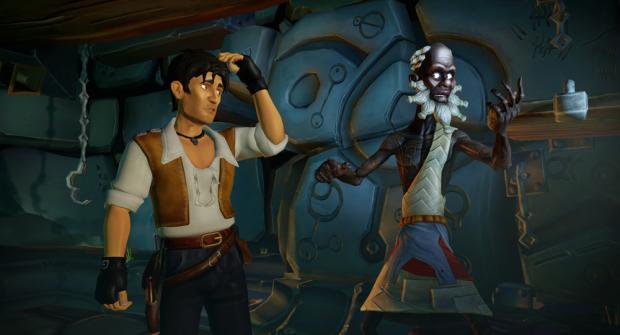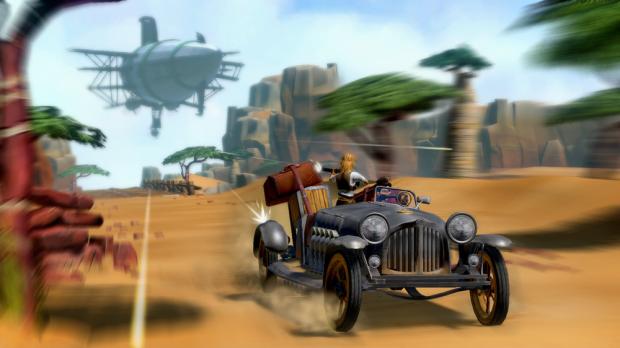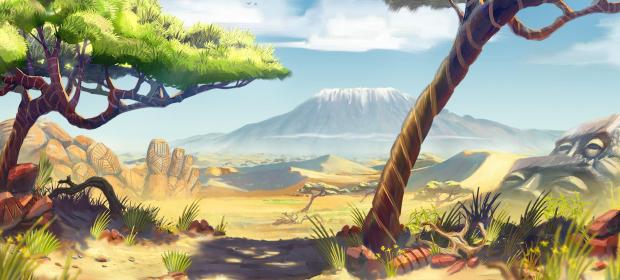You may not have heard of Jack Keane 2: The Fire Within, Deck 13 Interactive’s latest point & click adventure. Maybe it’s because you’re not a fan of the genre, maybe it’s because your head is still spinning after the Steam Summer Sale, or maybe it’s a more obvious reason: because it’s not a very good game. Now you would think, looking at the German developer’s back catalogue, that they know what they’re doing by now. After all, they have been based almost solely in the adventure genre since their formation. But you’d be wrong, and a few hours with Jack Keane makes that abundantly clear.
In the character’s defense, it isn’t he who makes the first misstep. This is left to his annoying sidekick, Amanda, who we are introduced to aboard an old galley bound for a Shanghai prison island as she attempts to rescue our eponymous hero. While she battles a mutinous crew outside, inside Jack is informed of an ancient treasure called Ukumba, by his African cell-mate. The shaman enters Jack’s subconscious in order to pass the knowledge of the treasure onto him and where he can find pieces of a lost amulet, the key to the treasure.
Unfortunately for all concerned, including the player, his mind is a mess and the valuable information is scattered about his brain. Jack must navigate through his own thoughts to find the clues to the amulet locations, and ultimately the resting place of Ukumba. Now I can suspend belief, of course, and accept this strange method of treasure hunting, but what I can’t accept is why the amulet pieces were lost in the first place. This shaman, who is the last alive with this invaluable knowledge, says he “lost or gave away” the amulet pieces. Really? That’s how you safeguard this secret? I can maybe understand losing something, but just wilfully giving away the precious shards? That’s just downright irresponsible.

Following a slow and contrived escape from the prison, helped by the inexplicable appearance of the Royal British Navy, Jack and Amanda head to Hamburg to find the first piece of the fated trinket. Here they join forces with German engineer Carl and the alluring journalist Eve and, after ending what has to be the most poorly organised strike in history, they depart for Africa, amulet piece in hand. The quest takes the team across the continent from the Nile delta to the dusty Savannah and finally to Mt. Kilimanjaro, all the while competing with the evil Professor Umbati, who also seeks the lost prize.
To say the plot is mediocre is being kind. It’s the same old quest for fortune and glory that so many adventure games tell and it could have maybe been forgiven if the other areas of the game were stronger – but they’re not. The characters are completely lifeless, one-dimensional and unlikable, the locations are claustrophobic, small and bland, and dialogue is as unfunny as it is daft. I must applaud the developers for succeeding in creating characters that universally demand numerous punches to the face, regardless of sex. Kudos must also be awarded for taking exotic, interesting locales and managing to make them completely bereft of any sort of wonderment or intrigue.
Each change in scenery is preceded by Jack diving into his subconscious in order to uncover the next clue to the treasure, guided by the spiritual remains of the mystical shaman. These dream sequences attempt to flesh-out the experience by exploring the Jack’s psyche and motivations but it’s ultimately superficial nonsense, due to the inherent weakness of his character.

As with any game of this nature, the plot and gameplay are closely intertwined and if one suffers so does the other. It plays like any other point and click, which isn’t necessarily a bad thing, and it does make attempts at implementing its own new features. One that works quite well is the moving of your character about the scene. Right-clicking and holding in front of Jack causes him to walk, and moving the cursor farther away from him triggers a run, with a left click making him jump. It’s one of the few aspects of the game that works well, and adds more speed and fluidity to exploring environments.
Unfortunately, this is countered by the terrible combat mechanic. The turn-based system is poorly imagined, completely unneeded and infuriatingly unavoidable, but thankfully crops up only a handful of times. When facing an opponent, Jack must first choose a defensive move, as the attacker always strikes first. After a successful dodge, you are given a limited time to choose an offensive action that may or may not succeed, depending on your enemy. New moves can be picked up along the way, usually taught by NPCs in each new area entered. While you can’t knock Deck 13 for attempting something new, you just have to wonder why they wasted time on something so uncalled for that does not enrich the game in any way.
Of course, the bread and butter of the point and click is the puzzles, and sadly Jack Keane 2 doesn’t even get this right. There are far too many riddles that have no basis in reality, and these are the ones outside of the dream sequences. Idiotic and outlandish combinations and unnecessary fillers dominate the game, and when you do find yourself in Jack’s mind it’s even worse. At least back in the real-world portions, you can try to apply logic to the enigmas, but in Jack’s subconscious all rules go out the window – so get ready to click anything that moves in a vain attempt to solve the problems.

So, the story is very bad and the gameplay is pretty bad, but what about the visual and audible elements? Well, all credit to Deck 13 for their consistency because these are also awful. The first thing that strikes you is the voice “talents” – in particular, Jack’s companion Amanda. Within about 5 seconds of booting up the game your ears are assaulted by her performance, because it sounds like it was recorded with a TalkBoy in the back seat of a car. The terrible, stilted exchanges between characters are only surpassed by the awful audio mix in the game in general. Random portions of dialogue suffer from low volume for no apparent reason and sometimes certain audio cues don’t even trigger, leaving you to endure the banal, forgettable score.
Your eyes aren’t subjected to the same level of incompetence but it’s not far off. The game’s dull backgrounds seem to lack any noticeable textures even though their diminutive size should allow a decent amount of graphical fidelity. Cartoonish visuals, while suitable to the tone, are uninspired and have been done much better by games of a higher calibre. Character animations are awkward even in the cut-scenes, and the camera is poorly placed at times and can be very buggy, leaving you to try to blindly navigate your character back into frame.
VERDICT: Point and click adventures have a hard enough time drawing new players in without games like this tainting their waning reputation. This is definitely not the saviour of the genre; it’s sadly just one to avoid.

BAD. Ugly, lazy, and unpleasant, if we’ve scored a game so low then it has serious issues. A 3/10 game will suffer from a combination of uninspired, lacklustre design, unfixed bugs and poor presentation.





